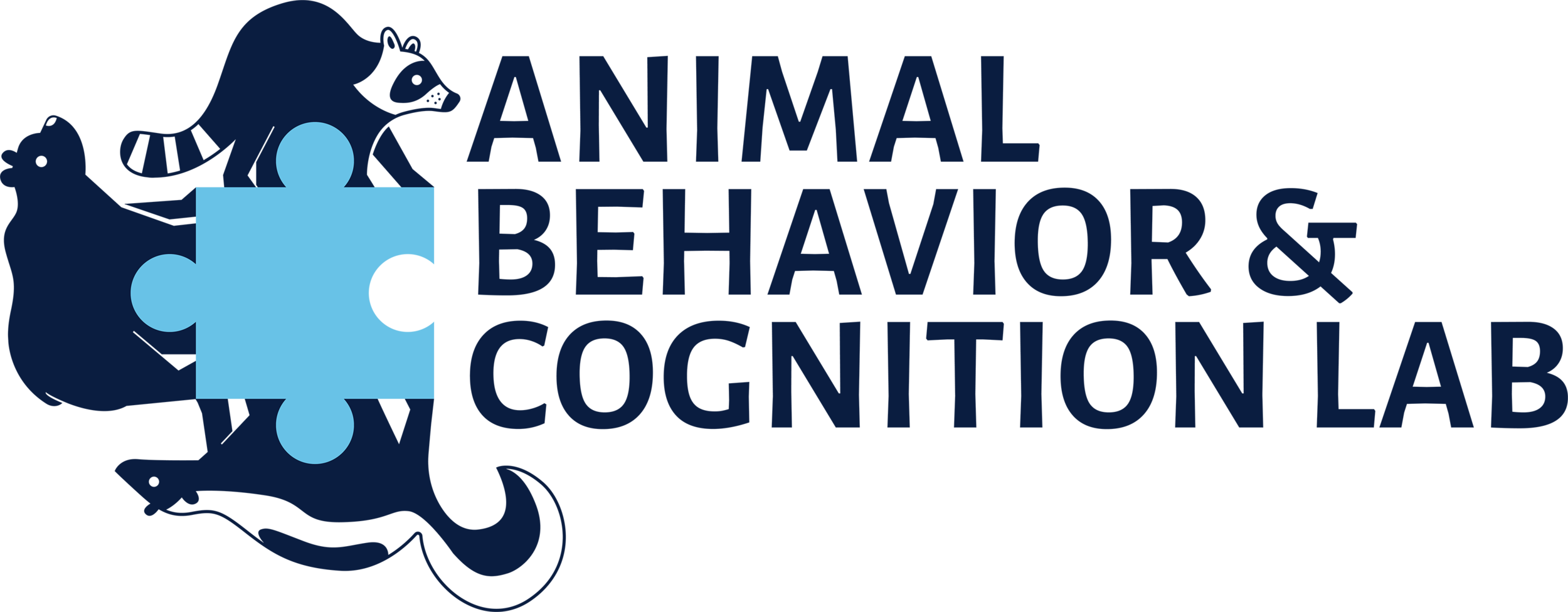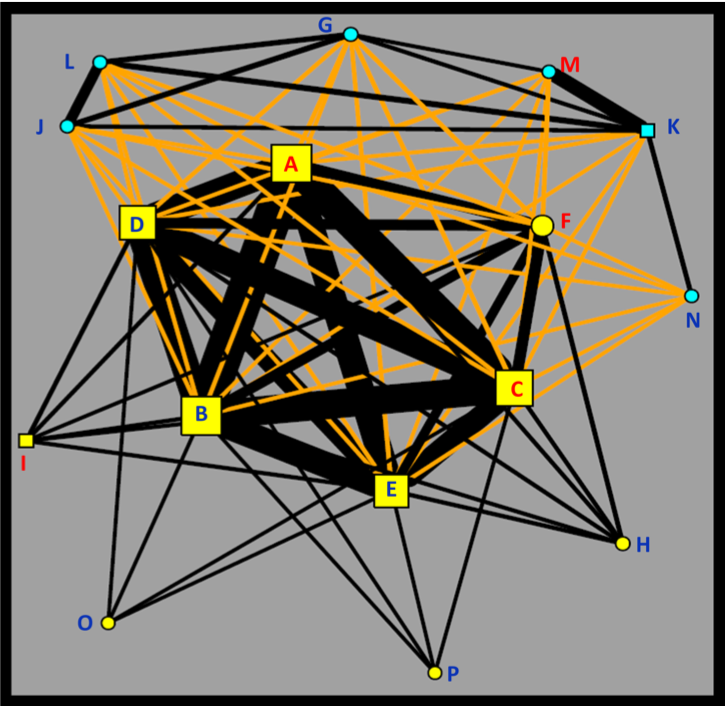Social influences on cognition
Social learning is a powerful mechanism that animals can use to rapidly and efficiently acquire accurate information about their environment. Social learning theory (Laland 2004) hypothesizes that animals will use social learning strategically. For example, animals may preferentially learn from dominant or related group members. We are examining the social learning capabilities of animals and investigating how the physical and social environments may change the degree to which animals use social learning.
In urban environments, social learning may be particularly beneficial when wildlife are taking advantage of novel or timed resources, learning how to evade novel predators, and when navigating through new or changing environments. Additionally, the abundance and distribution of resources in urban environments may be causing animals to live in closer proximity to each other, which could lead to increased opportunities for social learning. We are constructing social networks for wild raccoon populations and examining whether animals that are more connected in the social network exhibit more social learning than less-connected animals (Fanelli et al. in prep; Stanton et al. in review). We have also used controlled studies with captive zebra finches, captive and wild spotted hyenas, and zoo-housed elephants to examine whether individuals learn more from watching preferred conspecifics (Templeton et al. 2017), whether captive and wild individuals demonstrate similar social learning capabilities (Benson-Amram et al. 2014), and the role of social learning in the problem-solving performance of a social, long-lived, yet understudied mammal (Barrett and Benson-Amram 2020).
Project collaborators
Dr. Kay Holekamp
Michigan State University
Dr. Dave McDonald
University of Wyoming
Dr. Chris Templeton
Pacific University
Dr. Eli Bridge
University of Oklahoma
Major findings from this theme
Wild and captive spotted hyenas learn from watching conspecifics solve a novel problem and use the same, relatively simple, mechanism of social learning as vervet monkeys and macaques. We presented a novel puzzle box to wild and captive spotted hyenas and asked whether there were social influences on the problem-solving abilities of hyenas (Benson-Amram et al. 2014). We found that naive hyenas approached the puzzle box faster (were less neophobic) when another hyena was present. We also found that captive hyenas who watched a knowledgeable demonstrator solve the problem were less neophobic than captive hyenas that did not see a demonstrator. However, social learning opportunities did not affect problem-solving success in either captive or wild hyenas. It appears that the limited social learning shown by hyenas on this task was likely based on localized stimulus enhancement. This work is important in helping to validate captive studies of social learning because it is one of only a few studies to use the same experimental apparatus to investigate social learning in both wild and captive populations of a single species and it found that individuals from both populations show very similar results.
Zoo-housed Asian elephants failed to solve a new problem after watching a demonstrator elephant solve it but some observers showed an increased interest in the task compared to elephants in the control group. We tested 12 Asian elephants at two zoos in the United States with a floating object task (Barrett and Benson-Amram 2020). One elephant learned to solve the problem on her own. We also trained another elephant to solve the problem. These two elephants then served as demonstrators for naive elephants. Observers were no more successful at solving the problem than control elephants. However, observer elephants at one zoo did show an increased interest in the task, which demonstrates social learning via stimulus enhancement.
Female zebra finches copy the foraging choice of their mate whereas male zebra finches avoid the foraging choice of their mate. Partners with a strong social relationship, such as monogamous pair bonds, may be more likely to coordinate their behavior and learn from each other’s actions than partners with a weaker relationship (Laland 2004; Swaney et al. 2001). We found that zebra finches use social information when making foraging decisions and copy the foraging choice of a demonstrator (Templeton et al. 2017). Interestingly, not all individuals used this social information in the same way, and sex and pairing status interacted to influence the use of social information in zebra finches.
Wild juvenile raccoons in an urban environment are strongly connected in the social network and show evidence of social facilitation. We presented a novel cognitive testing device to wild raccoons and found that juveniles were more likely to approach and engage with the device than adults (Stanton et al. in review). We also found that juveniles would consistently arrive at the experimental location in groups compared to the adults, who would often arrive alone. We think that the increased tendency of juveniles to habituate to the testing device is primarily being driven by their social environment and the reduction in neophobia caused by social facilitation, a form of social learning. Interestingly, juveniles made more errors than adults on the reversal-learning task that we tested them on. We think this is because the juveniles experienced significantly more social interference than adults due to competition over access to the device with other juveniles in their social group. We constructed social networks of the wild raccoons that visited our experimental locations and we found that the juveniles are strongly connected to each other and form the core of the network (Fanelli et al. in prep). Adults are less connected than juveniles and the different communities of adults are connected together by the core group of juveniles.
Watch this video summary of a group of juvenile raccoons competing over access to a cognitive puzzle.
Featured publications
Fanelli R, Stanton L, McDonald D, Benson-Amram S. In preparation. Juveniles play a central role in the social networks of wild raccoons.
Stanton L, Bridge E, Huizinga J, Benson-Amram S. In review. How environmental, individual, and social traits of free-ranging raccoons (Procyon lotor) influence participation and performance in cognitive testing. Journal of Experimental Biology
Barrett, L.P. and S. Benson-Amram. 2020. Can Asian elephants use water as a tool in the floating object task? Animal Behavior and Cognition, 7(3), 310-326.
Templeton, C. N., Philp, K., Guillette, L. M., Laland, K. N. & Benson-Amram, S. 2017. Sex and pairing status impact how zebra finches use social information in foraging. Behavioural Processes 139. (doi:10.1016/j.beproc.2016.12.010)
Benson-Amram, S., Heinen, V. K., Gessner, A., Weldele, M. L. & Holekamp, K. E. 2014. Limited social learning of a novel technical problem by spotted hyenas. Behavioural Processes 109. (doi:10.1016/j.beproc.2014.09.019)

